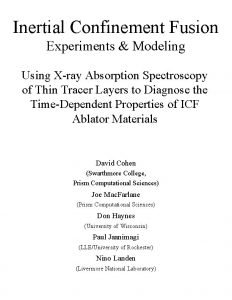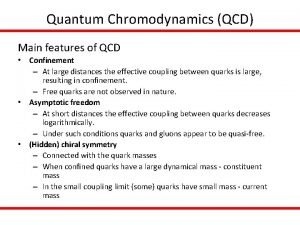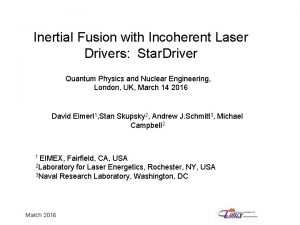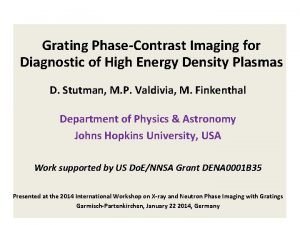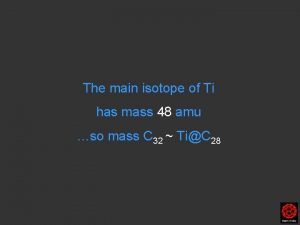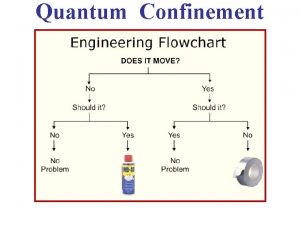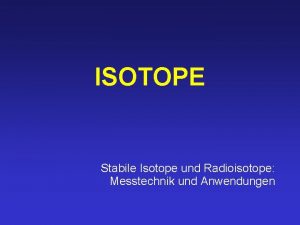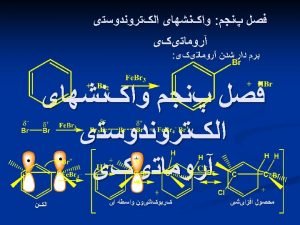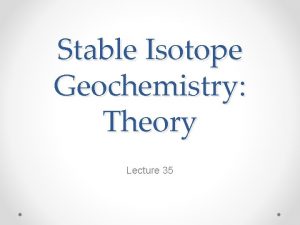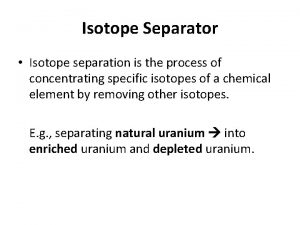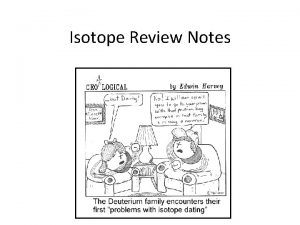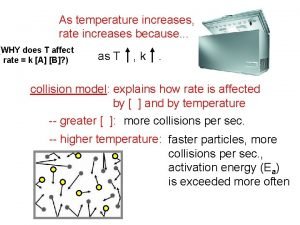213 Introduction Energy confinement time increases with isotope





![Ti [ke. V] ne [1019 m-3] r/a r/a ci [m 2/s] Te [ke. V] Ti [ke. V] ne [1019 m-3] r/a r/a ci [m 2/s] Te [ke. V]](https://slidetodoc.com/presentation_image_h2/a511ec4f95f90ff7af1056c3000ed015/image-6.jpg)


![Edge pedestal characteristics 200 hydrogen 150 f. ELM [Hz] 165 Hz 100 80 Hz Edge pedestal characteristics 200 hydrogen 150 f. ELM [Hz] 165 Hz 100 80 Hz](https://slidetodoc.com/presentation_image_h2/a511ec4f95f90ff7af1056c3000ed015/image-9.jpg)

![Higher pedestal pressure is obtained in deuterium H-mode plasmas Teped [ke. V] 2 deuterium Higher pedestal pressure is obtained in deuterium H-mode plasmas Teped [ke. V] 2 deuterium](https://slidetodoc.com/presentation_image_h2/a511ec4f95f90ff7af1056c3000ed015/image-11.jpg)


- Slides: 13


2/13 Introduction Energy confinement time increases with isotope mass tth Mz with z greater than 0. 1. 5 deuterium 1 Wth [MJ] Knowledge of the influence of the hydrogen isotope on H-mode confinement is essential for accurately projecting the energy confinement in future burning plasmas. 0. 5 hydrogen tth PL-0. 69 1. 1 MA, 2. 4 T 0 0 2 4 6 Pabs [MW] This favorable dependence of confinement on isotope mass leads to optimistic visions for a future reactor. However, the underlying physics behind the role of the hydrogen isotope has not yet clearly been understood. 8 10 12

3/13 Objective 1. Investigate the dependence of the core heat transport on the isotope focusing on Ti profiles 2. Examine how the hydrogen isotope is involved in the physics picture of overall H-mode confinement Pedestal Core Shafranov shift p(r) Poloidal beta Pedestal stability Profile stiffness Pedestal structure separatrix In the present understanding, H-mode confinement is characterized by separating into pedestal and core components. p, j DWELM D/a ~ bp 1/2 Heat source ELM hydrogen isotope The experiments on hydrogen and deuterium H-mode plasmas in JT-60 U were used for analysis.

Experiment on hydrogen and deuterium H-mode plasmas Ha WTOT 0 6 9 8 time [s] 10 0 11 [MA] ne Da 0 1. 5 WTOT 0 6 2 bp. TOT 7 9 8 time [s] 10 0 11 [a. u. ] 2 7 bp. TOT 0 4 0 2 [MJ] 0 1. 5 [MJ] 0 2 0 9. 2 9. 3 time [s] 9. 4 0 9. 2 9. 3 time [s] Te [ke. V] [a. u. ] ne 0 4 PNBI [1019 m-3] 0 2 1. 5 Ip [MW] [MA] [MW] PNBI 15 [a. u. ] 1. 5 Ip [1019 m-3] 15 D 9. 4 f. ELM = 170 Hz (Psep=6. 7 MW) f. ELM = 80 Hz (Psep=6. 6 MW) Ip = 1. 08 MA, BT = 2. 4 T q 95 = 3. 7, d = 0. 35 ne = 2. 2 x 1019 m-3 bp = 0. 6 (H) and 0. 9 (D) Ti [ke. V] Pabs = 7. 3 MW H H: Wth = 0. 7 MJ, Zeff = 1. 4 D: Wth = 0. 9 MJ, Zeff = 2. 4 ne [1019 m-3] Power scan has been attempted to examine the characteristics of hydrogen and deuterium H-mode plasmas. 4/13 r/a

tth for deuterium is larger by 20 -30% than for hydrogen at a given power 5/13 The tth decreases continuously with Pabs for both cases as expected from IPB 98 y 2 scaling. However, tth is larger by 20 -30% for deuterium than for hydrogen at a given Pabs. A pair of H and D plasmas with the same Wth are chosen for comparison. The power required to sustain the same Wth is greater for H (Pabs = 8. 0 MW) than for D (Pabs = 4. 0 MW) by a factor of two. Therefore, tth of 0. 1 s for H becomes half that for D (tth = 0. 2 s).
![Ti ke V ne 1019 m3 ra ra ci m 2s Te ke V Ti [ke. V] ne [1019 m-3] r/a r/a ci [m 2/s] Te [ke. V]](https://slidetodoc.com/presentation_image_h2/a511ec4f95f90ff7af1056c3000ed015/image-6.jpg)
Ti [ke. V] ne [1019 m-3] r/a r/a ci [m 2/s] Te [ke. V] VT [102 krad/s] r/a 6/13 Qi [10 -15 W m] Profiles of ne, Te and Ti become identical while ci is smaller for deuterium throughout the minor radius r/a The profiles of Ti, Te and ne are obviously identical. The Qi for H is larger than for D. Therefore, the ci for H also becomes explicitly higher than for D. A larger number of perp-NBs were injected for H to keep Wth the same. This operation leads to a larger ripple loss of fast ions, which enhances the V T toward the counter direction.

Reduced ion heat diffusivity for deuterium accompanying steeper temperature gradient 7/13 The characteristics of ion heat transport are shown in a diagram of Qi/ni and Ti. Increased power For both cases, the increase of Ti is less significant than that of Qi/ni, indicating that ci increases gradually with the heating power. The increase of ci with the heating power is more rapid for H than for D. The angle q formed between the horizontal axis and a straight line that passes through both the data and the origin of the coordinates corresponds to ci (= tanq).

Ion-temperature-gradient scale length is smaller with hydrogen isotope mass R / L Ti 6 0 2 4 6 8 10 hydrogen deuterium r/a = 0. 6 ci increases rapidly with Ti/Ti for both H and D plasmas, indicating the profile stiffness in the variation of the heating power in this exp. (A) ci [m 2/s] 4 8/13 As expected from the same Ti profiles for (A) and (B), the ci for H is nearly two times larger than for D with the same Ti/Ti. 2 cineo linear ITG threshold (B) 0 0 1 2 Ti / Ti [m-1] 3 Considering the characteristics of the rapid increase of ci with Ti/Ti for each hydrogen isotope species, this result is indicative of a smaller LTi for deuterium plasmas.
![Edge pedestal characteristics 200 hydrogen 150 f ELM Hz 165 Hz 100 80 Hz Edge pedestal characteristics 200 hydrogen 150 f. ELM [Hz] 165 Hz 100 80 Hz](https://slidetodoc.com/presentation_image_h2/a511ec4f95f90ff7af1056c3000ed015/image-9.jpg)
Edge pedestal characteristics 200 hydrogen 150 f. ELM [Hz] 165 Hz 100 80 Hz 1. 1 MA, 2. 4 T 0 0 2 4 6 Psep [MW] 8 10 25 DWELM [k. J] 20 deuterium PELM/Psep = 20% 15 In (f. ELM/Psep, DWELM) space, the product of both axis quantities indicates the power fraction assigned to ELM loss from the separatrix power. ELM loss power PELM (= f. ELM DWELM) for D remains ~20% of Psep while it is ~10% of Psep for H. PELM/Psep = 10% 10 5 0 f. ELM increases almost linearly with Psep for both cases; a typical feature of type-I ELMs. At a given Psep, f. ELM for H becomes approximately two times larger than that for D. Over wide range of Psep, DWELM is smaller by a factor of ~2 for H than that for D. deuterium 50 9/13 hydrogen 0 10 20 30 f. ELM / Psep [Hz / MW] The result indicates that the power assigned to the inter-ELM transport for D is smaller than that for H.

Edge pedestal characteristics Pabs 10/13 Despite a given Pabs, the pedestal Ti value becomes higher for D than for H. Non-dimensional parameter scan in JT-60 U has shown pedestal width Dped scales as bpped 0. 5 while there is nearly no dependence on rpped* [1]. This result indicates that Dped is not changed directly by isotope species. However, the pedestal temperature profiles are clearly different between two cases. Discuss how this difference in the pedestal temperature appears. [1] H. Urano et al, Nucl. Fusion 48 (2008) 045008
![Higher pedestal pressure is obtained in deuterium Hmode plasmas Teped ke V 2 deuterium Higher pedestal pressure is obtained in deuterium H-mode plasmas Teped [ke. V] 2 deuterium](https://slidetodoc.com/presentation_image_h2/a511ec4f95f90ff7af1056c3000ed015/image-11.jpg)
Higher pedestal pressure is obtained in deuterium H-mode plasmas Teped [ke. V] 2 deuterium 1 3. 0 k. Pa hydrogen 1. 5 k. Pa 1. 08 MA, 2. 4 T Pabs = 8 -9 MW 0 0 neped 1 [1019 m-3] 2 deuterium bpped (A) 0. 2 0. 1 hydrogen (B) 1. 08 MA, 2. 4 T 0 0 0. 2 0. 4 0. 6 0. 8 bp. TOT Pedestal pressure evidently differs nearly by a factor of ~1. 5 between H and D plasmas. The difference of pped is mainly attributed to the difference of Tped. The edge stability can be improved by the increase in bp. TOT [2 -4]. The bpped is increased with increased bp. TOT for both cases. Despite different types of isotope species, the relationship between bp. TOT and bpped is almost identical. 0. 4 0. 3 11/13 1 1. 2 Why is larger bp. TOT obtained for D? Better thermal energy confinement for D is one of the contributors. Fast ion energy is also proportional to m 0. 5. [2] Y. Kamada et al, Plasma Phys. Control. Fusion 48 (2006) A 419 [3] P. B. Snyder et al, Nucl. Fusion 47 (2007) 961 [4] A. W. Leonard et al, Phys. Plasmas 15 (2008) 056114

Schematic view of H-mode confinement involving hydrogen isotope effect Pedestal Core (ii) Pedestal stability Poloidal beta Fast ion Hydrogen energy isotope Profile stiffness separatrix Shafranov shift p(r) (i) p, j Pedestal structure D/a ~ bp 1/2 Heat source - 12/13 f. ELM DWELM (i) Pedestal plays a role as a boundary condition determining the core confinement through profile stiffness (ii) Pedestal stability is improved with increased bp ELM Reduced heat transport for deuterium improves core confinement. The bp becomes higher for deuterium. Increased bp improves the edge stability and raises the pedestal pressure. Higher pedestal in turn allows higher core confinement due to profile stiffness.

Summary 13/13 The hydrogen isotope effect on H-mode confinement was examined using hydrogen and deuterium H-mode plasmas in JT-60 U tokamak. (1) The tth was larger by 20 -30% for deuterium than for hydrogen over a wide range of power. (2) When Wth was fixed, the profiles of ne, Te and Ti became nearly identical for both cases while higher heating power was required for hydrogen. The ci for hydrogen was higher than that for deuterium. (3) Ion temperature gradient scale length was smaller for deuterium compared with that for hydrogen. (4) The relationship between bp. TOT and bpped was nearly the same regardless of the difference of the isotope species.
 York will end longterm solitary jails
York will end longterm solitary jails Projet enseignement scientifique exemple
Projet enseignement scientifique exemple Inertia xray
Inertia xray Confinement qcd
Confinement qcd Inertial confinement
Inertial confinement Inertial confinement
Inertial confinement Confinement principle in computer system security
Confinement principle in computer system security Solitary confinement effects
Solitary confinement effects 15-213 introduction to computer systems
15-213 introduction to computer systems 15-213 introduction to computer systems
15-213 introduction to computer systems Energy energy transfer and general energy analysis
Energy energy transfer and general energy analysis Energy energy transfer and general energy analysis
Energy energy transfer and general energy analysis Elapsed time
Elapsed time Ti-48 isotope
Ti-48 isotope


